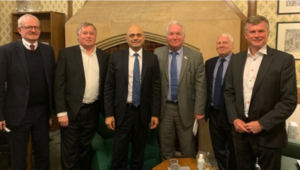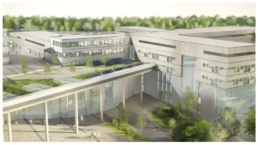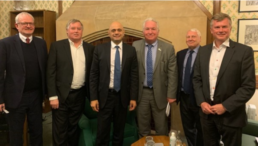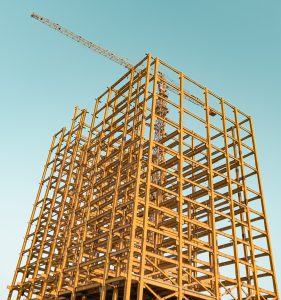HARLOW SHOWS THE WAY - AND SHAMES WATFORD
HARLOW SHOWS THE WAY TO A CLEAR NEW SITE HOSPITAL - AND PUTS WEST HERTS TO SHAME
Harlow's Princess Alexandra Trust are showing how an imaginative NHS body can plan new clear-site hospitals that work for patients.
The Essex team want an efficient new hospital on a human scale - up to seven or eight storeys - in a spacious setting with room to breathe. By contrast West Herts want us to squeeze into a 16-storey, 260-foot monstrosity, surrounded by Watford's biggest new housing estate - the 1500-unit Riverwell.
In this blog, Walking the Tightrope, the Trust explain the thinking behind their choice of a hospital that is in the right environment for healing.
A much better use of public money than Watford's towering infirmary.
TRUST TO REVIEW NEW HOSPITAL SITE OPTIONS

REVIEW OF DECISION TO BUILD AT WATFORD GENERAL AS TRUST BOW TO PRESSURE
Opposition to plans to redevelop Watford General has forced West Herts Trust to agree to review their decision. Amid signs that support for the Trust’s proposals among key local councils is crumbling, the Trust say they will be taking a ‘fresh eyes approach’ to the decision at a Board meeting on 31 May.
The U-turn follows a February meeting at which local health group the New Hospital Campaign (NHC) and others put their case for a new hospital on a clear and accessible central site to Health Secretary Sajid Javid.
In a letter sent today to Phil Townsend, the Trust Board Chair, NHC Co-ordinator Philip Aylett says:
‘I am glad that you and your colleagues are, at last, now apparently prepared to challenge officials to justify their approach.
‘The imminent departures of both the CEO and Deputy CEO, the present hiatus in the New Hospital Programme, the Secretary of State’s consideration of the evidence presented to him by the NHC and, maybe, some of the NHS failings we have heard about recently, all offer the Board a convenient and valuable opportunity to re-set.’
The NHC today sent the Trust their contribution to the review - the detailed submission the Campaign made to the Secretary of State following the meeting with him in February. That recommended that an independent expert body should be commissioned ‘to carry out a full review of options for acute redevelopment in West Hertfordshire. This review should include options for a clear site.’
To read the full press release click here
Click here for the letter sent today to Phil Townsend, West Herts Hospital Trust Chairman
For our full submission to Sajid Javid, Secretary of State for Health, click here
WEST HERTS NEEDS A TRULY NEW HOSPITAL

WHY WATFORD GENERAL WON’T WORK - NHC Update February 2022
This update on hospital redevelopment in West Hertfordshire comes from the New Hospital Campaign (NHC), which is calling on the Government and the NHS to locate a new emergency care hospital for the area on a clear central site.
West Hertfordshire has been promised funding as one of the first of the new hospitals in the Government’s programme, but it’s vital that this investment is made in the right place. An emergency care hospital should be accessible to everyone across West Herts, offering a healing environment and providing value for money.
A hospital on a new site, convenient for all, could provide:
- A good environment for care, with buildings on a human scale, decent landscaping and room to expand as our population grows
- Convenient, easy parking, especially for people with mobility problems
- Planned access by road and public transport from all of the area
- Buildings that help achieve zero carbon, are suited to new technology, and offer single rooms for privacy and infection control
- Speed of construction, as building can go on without interruption or disruption
There are several possibilities for clear new sites, easily accessible from everywhere in the area, but none has yet been properly assessed by the West Hertfordshire Hospitals NHS Trust (West Herts Trust), who continue to insist that new hospital facilities must be located at or around Watford General Hospital.
The NHC case was put to the Health and Social Care Secretary, Sajid Javid, on 7 February, when representatives from the Campaign took part in a delegation led by Sir Mike Penning MP. We look forward to positive results from that meeting.
Refusal to consider alternatives
The West Herts Trust say that redevelopment must take place at and around the increasingly cramped current site of Watford General in Vicarage Road. They constantly manipulate the facts to support this view. They did not, for instance, properly assess the risks of redeveloping at Watford General before the decision was taken to reject all new site options in favour of Watford in October 2020. This was a serious error.
But other trusts are taking a different route
The West Herts Trust’s attitude is baffling: in nearby Harlow the Princess Alexandra Hospital Trust, faced with the same choice of blundering on with redeveloping an existing, cramped town centre site or building anew on a clear ‘out-of-town’ site, have chosen the new site.
The Harlow Trust have analysed the evidence for a hospital on a clear site, and concluded it would be built much faster and more cheaply and give far better results for patients.
The huge flaws in the West Herts Trust’s plans
West Herts NHS Trust stubbornly refuse to admit that
WATFORD GENERAL WON’T WORK.
That refusal to look at alternatives flies in the face of common sense and is – unsurprisingly – creating a number of critical problems.
Lack of space is one of the biggest difficulties for their Watford plans.
The Trust are trying to fit a 1000-bed new hospital facility into a plot that is half the size of the current one. It’s a mystery why the Trust have given up so much of their land. But the answer may lie in the murky depths of the so-called Watford Health Campus, an agreement under which developers and Watford Council have been planning large amounts of residential and other development on and around the current hospital site.
Squeezed into a small space, the Trust have had to plan to build high. The Trust’s current proposals would see demolition of most existing buildings at Watford and the building of three tall towers, the biggest 270 feet high – making it the tallest NHS building outside central London. It would of course look ridiculous among the (mostly) two-storey houses of West Watford. Furthermore, if the unthinkable were to happen, local fire services are not adequately equipped to deal with a fire in a building more than 150 feet high.
The Trust have also known for nearly a year that these towers would break the budget – it would cost over £900m to build and equip the three towers as designed. The money simply isn’t there from the Treasury for what the Trust plan to do.
So the Trust will have to curb their enthusiasm for their towering infirmary. But redeveloping at Watford General in other ways would almost certainly mean having to retain and refurbish the existing buildings - which are in a desperate state.
Over three years ago, an expert survey of the condition of the Watford General buildings concluded:
- Almost all of the buildings were in an unsatisfactory condition and not ‘functionally suitable’
- The site services infrastructure - including electrical, steam heating system and hot water - was at the end of its life
- It would cost at least £240 million to catch up with the maintenance backlog
The situation has got worse since that survey was done – there are over 1000 maintenance call-outs a month at Watford.
But any redeveloped or new facilities at Watford General would suffer other serious problems:
- A poor environment – there will be serious overdevelopment of the constrained site around Watford General, with a total of 1500 flats and houses, a hotel, a school and industrial units either built or planned
- The likely move of the Mount Vernon Cancer Centre to the Watford General site will add further congestion
- The Watford site is mostly steeply sloping, and there are pollution and flooding problems that have not been properly investigated. That makes development expensive and subject to many risks
- The construction noise, dust and pollution just a few metres away will disrupt the lives of patients and staff at the existing Watford hospital for many years - probably for the rest of the decade
- The expense needed to redevelop Watford would deprive the Trust’s other hospitals, at Hemel Hempstead and St Albans, of much-needed investment.
- Already poor access will get worse as car park places are cut and the site’s overdevelopment increases traffic. Greener travel is vital, but the Watford General car park spaces are being reduced immediately – with no funded plans in place for alternative means of transport in the near future
- Travelling to Watford from Hemel Hempstead, St Albans and elsewhere across West Herts is bad enough now – it will only get much worse.
The Trust seem to have run out of Watford redevelopment options that would be good for patients, as well as being both affordable and providing value for money. They are struggling to produce a preferred option - that is months away from being decided.
2022 MUST BE THE YEAR THE TRUST TURN TO PRACTICAL ALTERNATIVES TO THEIR FAILING WATFORD PLANS
There are a number of realistic possible alternatives to the Trust's faltering and delayed plans for Watford. These would see an easily-accessible emergency care hospital on a clear new site, combining with vibrant local hospitals to serve the whole community of West Hertfordshire.
This would not have to re-invent the wheel - there are elements of the Trust's existing plans which could be adapted to fit with an emergency care hospital on a new central, out-of-town site. All that is needed is a rational approach which moves away from the Trust's obsessive determination to redevelop emergency care at Watford General.
The Trust should now reconsider their decision to reject new site options for an emergency care hospital. They need to commission a proper independent study of all the alternatives, this time based on credible evidence.
The New Hospital Campaign is a collaboration between Dacorum Health Action Group, Dacorum Patients Group, and campaigners from Berkhamsted and St. Albans to share ideas and strategies to fight specifically for a new A&E hospital for West Herts in a more central location.
*Journalists and members of the media, please click here for our full press release
NHC meets with Health Secretary Sajid Javid
NHC call on Trust to seek new bids for greenfield sites after Health Secretary meeting

Health Secretary Sajid Javid is to look into the West Herts Trust decision to redevelop Watford General. This heartening progress on the saga came after a face-to-face meeting including NHC campaigners in Mr Javid's House of Commons office.
The Campaign today called on the Trust to look again at all the four new clear greenfield sites wrongly rejected in 2020 - and to invite new bids to make sure patients and taxpayers get the best deal.
NHC Co-ordinator Philip Aylett and building expert Bob Scott were part of a delegation led by Hemel Hempstead MP Mike Penning. Bob pointed out the dire conditions at Watford, with buildings in a bad state of repair and services not fit for purpose. But the Trust's plans for a budget-busting 17-storey triple tower hospital on the severely sloping site won't work either.
Philip explained that Watford General was inaccessible and unpopular, and showed Sajid that the decision to reject all clear new sites was based on flimsy, incomplete and 'subjective' evidence that shouldn't have been used and won't wash with the Treasury. He called on the Trust to carry out a search for new clear greenfield sites that could be better than Watford and offer more than any current greenfield proposals.
To read the full press release issued by Mike Penning click here
The Future Of Our Hospitals: Your Views

Virtual Public Meeting on Zoom, 8th December 2021 7:30 pm to 9:00 pm
We are inviting residents of West Hertfordshire (Hertsmere, Three Rivers, Dacorum, Watford Borough, St. Albans District) to let us know your ideas on improving hospital services for all of us in West Herts.
The New Hospital Campaign is holding this virtual public meeting on how best to develop the area's hospitals.
All views are welcome- whether you support acute development at Watford General or want a different solution.
Our Zoom account is limited so please contact NHC coordinator, Philip Aylett, on philip.aylett@gmail.com to get the link.
Virtual places are offered first come, first served.
We hope to record the meeting but will only do so if everyone agrees to be recorded.
If you aren't able to join us on the day, but would like to share your views please email dhag.org.uk@gmail.com detailing your view.
FLOOD RISK WORK HAMPERED BY STAFF SHORTAGES

The system for managing flood risks in Hertfordshire is in trouble. ‘Severe’ staff shortages have forced Hertfordshire County Council’s flood planning risk experts to admit they are ‘unable to take on any new work except in the most exceptional of circumstances’.
And the Environment Agency admits it often can’t meet crucial consultation deadlines on Hertfordshire planning applications.
In an astonishing email, the County Council says that ‘for most planning applications [it] will be unable to provide any comments’ on flood risks from new developments.
Who is checking on the flood risk at Watford General?
Doubts about the effectiveness of the system are surfacing even in relation to major projects that could cause severe flooding.
One example is the highly controversial high-rise hospital planned for Watford by the West Hertfordshire Hospital Trust. When the Trust was given outline planning permission by Watford Council for the 1000-bed 120,000 square metre building in July 2021, a series of crucial questions about flood risk and management put by the County Council were left unanswered. But serious flooding could undermine the viability of the whole project, one of the biggest in the whole programme of new hospitals. The blue light approach to the hospital has been badly affected by flooding.
Among other things, the Council demanded that the Trust should reduce the planned final discharge rate of surface water from the hospital site by a whopping 75 percent, and asked it to explain how it would manage the increased surface water runoff from the site.
The new hospital would be squeezed in as part of the ‘Riverwell’ development, which will see up to 1500 flats and houses, retail units, industrial buildings and a hotel added to a sloping site in crowded West Watford – an increasingly ambitious project, in itself presenting a raised risk of flooding.
West Herts situation beggars belief
Philip Aylett, Co-ordinator of the New Hospital Campaign, which supports the idea of a new hospital on a clear new site accessible to all in West Herts, said:
“The situation in West Hertfordshire beggars belief. Planning permission has been given to a massive hospital project on Vicarage Road, Watford with serious questions about flood risks left unanswered. The Trust’s plans for such a huge structure should never have been given the green light, in view of the uncertainty over flood risk."
For the full details and analysis into this critical matter, please click HERE for the full article.
PATIENTS LOSING OUT TO DEVELOPMENT IN KEY ‘NEW’ HOSPITAL PROJECT
A new report by the New Hospital Campaign reveals how a complex web of commercial land deals and management indecision have left plans for Watford General - one of the first ‘Pathfinder’ wave of Government’s new hospitals - in disarray. Building delays have increased and projected costs have run out of control. Crucially, the report shows that the West Hertfordshire NHS Trust has allowed political and commercial pressures to over-ride patients’ interests.
Work to redevelop emergency care facilities at the crumbling Watford General Hospital should have been completed by 2025, but now it looks as if it could take until 2030.
The Campaign, which argues that a new emergency care hospital on a clear central site would be best for West Hertfordshire, describes the Trust’s involvement in long-standing agreements with developers Kier Property and Watford Borough Council. It shows that the Trust:
- Failed to move quickly enough between about 2013 and 2017 to make use of the opportunity to expand the Hospital onto nearby land;
- Since then, the Trust has allowed the increasingly intrusive development of up to 1000 ‘residential units’ and commercial buildings very close to the existing Hospital, to the potential detriment of patients. Watford’s proposed new hospital facility will now be forced onto half the area of the current Hospital.
The full press release can be read here. The full report can be read here, with a summary document here. News About Watford Health Campus, published by Watford Borough Council in 2012-13, is here. The Campus Agreement is here and the Collaboration Agreement between the Trust and Kier is here
BILL FOR WATFORD HOSPITAL TOWERS OVER £900 MILLION

The cost of the planned 17-storey triple-tower block hospital for Watford General Hospital has soared to at least £900 million, according to expert calculations released today. The West Hertfordshire Hospitals Trust is persisting with the unaffordable high-rise plans despite clear instructions from the Government to cut back.
Building experts from the New Hospital Campaign (NHC) point out that the Trust risks wasting £8 million in fees on the scheme, which is the Trust’s ‘preferred option’ but now has no real chance of being built.
A new build hospital, on a clear central site, would cost significantly less to build as there would be no requirement to build such tall buildings. It could be built much faster too, reducing costs even further.
The plans for the UK’s tallest hospital outside central London, have increased by 50 percent in less than a year. Today they were described as ‘very expensive pie in the sky’.
To read our full press release click HERE
WATFORD COUNCIL APPROVE 'PIE IN THE SKY' PLANS FOR HIGH-RISE HOSPITAL

Watford borough council have approved an outline planning application for the re-furbishment of Watford General Hospital. The plans are for 3 high-rise buildings to occupy the current hospital site.
The New Hospital Campaingers believe that this is the wrong scheme in the wrong place and at 270 feet, this will be tallest NHS building outside London. In a densely populated suburban town, this will stick out like a sore thumb.
Costs are expected to be over £900 million, which would mean financial ruin for the local NHS. The Government have already told the Trust that they must cut their costs. These plans are purely pie in the sky thinking and if they were ever to actually be built, would cause at least 5 years of disruption and risk to patients at Watford.
The finished product of these short-sighted plans will be three intimidating and outdated tower blocks, which can never provide the healing environment we have been promised by architects.
There are other serious flaws with these plans which do not consider problems with poor air quality, wind tunnel effects between high buildings and worst of all serious flood risks.
We and our families will be stuck with these high-rises for sixty years, unless like so many old concrete 1960s tower blocks, they are demolished first.
The NHC, representing views of those across West Herts, continue to call for fresh thinking for a new hospital on a clean new site, easily accessible by people from all over West Herts. It should have medium-rise buildings that will be better for patients, cheaper and quicker to build than these concrete block towers.
PUBLIC DELIVERS STUNNINGLY NEGATIVE VERDICT ON HOSPITAL PLANS

Survey contains damning criticism of Trust’s stewardship of West Herts hospitals
Plans for redeveloping Watford General Hospital would make a bad situation worse, according to a damning survey of local public opinion. The independent survey commissioned by West Herts Hospital Trust, revealed less than 10% of public comments about the West Herts Hospitals Trust’s proposals for the Vicarage Road site were completely positive.
The survey also reveals that many local people are deeply unhappy with the current performance of the West Herts Trust in trying to provide a caring environment for patients and staff at Watford.
The New Hospital Campaign (NHC), which wants a truly new emergency hospital on a central site accessible for the whole area, says the survey, carried out in February and March this year, proves a complete reassessment of the project is urgently needed.
An NHC spokesperson commented “This survey shows the depth of the crisis of confidence which faces the West Herts Trust. It is doubly disturbing, revealing not only that many people are unhappy with the present environment at Watford General, but that the Trust’s expensive and impractical plans for the future inspire little faith in many West Herts people.”
“All in all, the public have delivered a stunningly negative verdict on the stewardship of the Trust and their plans for the future. Action is needed now to put this right. The option of building a new hospital on a clear central site, along with good facilities in all three towns, must be properly and honestly explored”.
You can read our full press release here, the New Hospital Campaign's response in full here and the survey feedback here.
The survey feedback is well worth taking the time to read. Thanks to all those in Dacorum who took the time to complete it, your voices were heard loud and clear. We encourage any residents of St.Albans & District who are also dissatisfied with plans to develop Watford General to contact us, to strengthen the cause for a brand new hospital on a clear central site.











